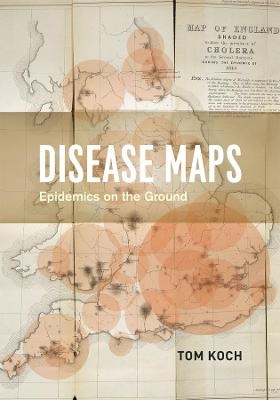
Disease Maps
Epidemics on the Ground
Seiten
2011
University of Chicago Press (Verlag)
978-0-226-44935-7 (ISBN)
University of Chicago Press (Verlag)
978-0-226-44935-7 (ISBN)
Contends to understand epidemics and their history we need to think about maps of varying scale, from the individual body to shared symptoms evidenced across cities, nations, and the world. This title provides a review of epidemic mapping today and a detailed example of its power.
In the seventeenth century, a map of the plague suggested a radical idea-that the disease was carried and spread by humans. In the nineteenth century, maps of cholera cases were used to prove its waterborne nature. More recently, maps charting the swine flu pandemic caused worldwide panic and sent shockwaves through the medical community. In "Disease Maps", Tom Koch contends that to understand epidemics and their history we need to think about maps of varying scale, from the individual body to shared symptoms evidenced across cities, nations, and the world. "Disease Maps" begins with a brief review of epidemic mapping today and a detailed example of its power. Koch then traces the early history of medical cartography, including pandemics such as European plague and yellow fever, and the advancements in anatomy, printing, and world atlases that paved the way for their mapping. Moving on to the scourge of the nineteenth century-cholera-Koch considers the many choleras argued into existence by the maps of the day, including a new perspective on John Snow's science and legacy.
Finally, Koch addresses contemporary outbreaks such as AIDS, cancer, and H1N1, and reaches into the future, toward the coming epidemics. Ultimately, "Disease Maps" redefines conventional medical history with new surgical precision, revealing that only in maps do patterns emerge that allow disease theories to be proposed, hypotheses tested, and treatments advanced.
In the seventeenth century, a map of the plague suggested a radical idea-that the disease was carried and spread by humans. In the nineteenth century, maps of cholera cases were used to prove its waterborne nature. More recently, maps charting the swine flu pandemic caused worldwide panic and sent shockwaves through the medical community. In "Disease Maps", Tom Koch contends that to understand epidemics and their history we need to think about maps of varying scale, from the individual body to shared symptoms evidenced across cities, nations, and the world. "Disease Maps" begins with a brief review of epidemic mapping today and a detailed example of its power. Koch then traces the early history of medical cartography, including pandemics such as European plague and yellow fever, and the advancements in anatomy, printing, and world atlases that paved the way for their mapping. Moving on to the scourge of the nineteenth century-cholera-Koch considers the many choleras argued into existence by the maps of the day, including a new perspective on John Snow's science and legacy.
Finally, Koch addresses contemporary outbreaks such as AIDS, cancer, and H1N1, and reaches into the future, toward the coming epidemics. Ultimately, "Disease Maps" redefines conventional medical history with new surgical precision, revealing that only in maps do patterns emerge that allow disease theories to be proposed, hypotheses tested, and treatments advanced.
Tom Koch is adjunct professor of medical geography at the University of British Columbia; director of Information Outreach, Ltd.; and a prolific writer, researcher, and public speaker specializing in the fields of gerontology, bioethics, medical cartography, and public health. He is the author of fifteen books, including, most recently, Cartographies of Disease.
| Erscheint lt. Verlag | 5.7.2011 |
|---|---|
| Sprache | englisch |
| Maße | 19 x 26 mm |
| Gewicht | 1077 g |
| Themenwelt | Schulbuch / Wörterbuch ► Lexikon / Chroniken |
| Studium ► Querschnittsbereiche ► Epidemiologie / Med. Biometrie | |
| Naturwissenschaften ► Biologie ► Humanbiologie | |
| Naturwissenschaften ► Geowissenschaften ► Geografie / Kartografie | |
| Sozialwissenschaften ► Ethnologie | |
| ISBN-10 | 0-226-44935-1 / 0226449351 |
| ISBN-13 | 978-0-226-44935-7 / 9780226449357 |
| Zustand | Neuware |
| Haben Sie eine Frage zum Produkt? |
Mehr entdecken
aus dem Bereich
aus dem Bereich
ein überfälliges Gespräch zu einer Pandemie, die nicht die letzte …
Buch | Hardcover (2024)
Ullstein Buchverlage
24,99 €


